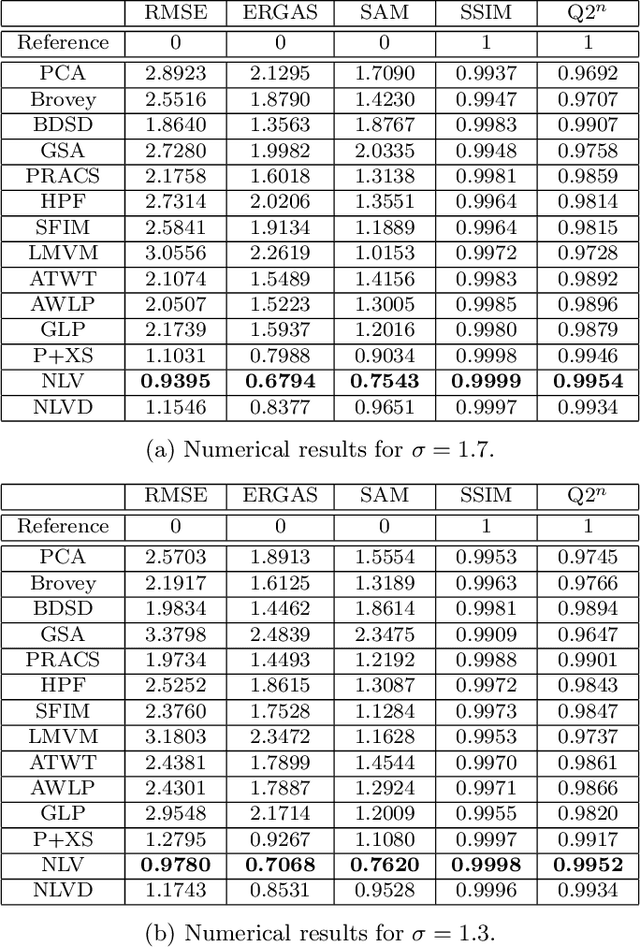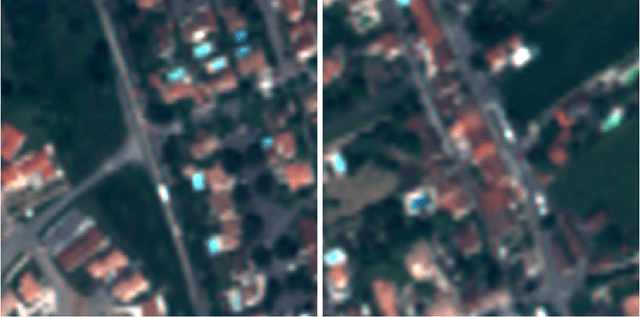Joan Duran
Model-Guided Network with Cluster-Based Operators for Spatio-Spectral Super-Resolution
May 30, 2025Abstract:This paper addresses the problem of reconstructing a high-resolution hyperspectral image from a low-resolution multispectral observation. While spatial super-resolution and spectral super-resolution have been extensively studied, joint spatio-spectral super-resolution remains relatively explored. We propose an end-to-end model-driven framework that explicitly decomposes the joint spatio-spectral super-resolution problem into spatial super-resolution, spectral super-resolution and fusion tasks. Each sub-task is addressed by unfolding a variational-based approach, where the operators involved in the proximal gradient iterative scheme are replaced with tailored learnable modules. In particular, we design an upsampling operator for spatial super-resolution based on classical back-projection algorithms, adapted to handle arbitrary scaling factors. Spectral reconstruction is performed using learnable cluster-based upsampling and downsampling operators. For image fusion, we integrate low-frequency estimation and high-frequency injection modules to combine the spatial and spectral information from spatial super-resolution and spectral super-resolution outputs. Additionally, we introduce an efficient nonlocal post-processing step that leverages image self-similarity by combining a multi-head attention mechanism with residual connections. Extensive evaluations on several datasets and sampling factors demonstrate the effectiveness of our approach. The source code will be available at https://github.com/TAMI-UIB/JSSUNet
Nonlocal Retinex-Based Variational Model and its Deep Unfolding Twin for Low-Light Image Enhancement
Apr 10, 2025



Abstract:Images captured under low-light conditions present significant limitations in many applications, as poor lighting can obscure details, reduce contrast, and hide noise. Removing the illumination effects and enhancing the quality of such images is crucial for many tasks, such as image segmentation and object detection. In this paper, we propose a variational method for low-light image enhancement based on the Retinex decomposition into illumination, reflectance, and noise components. A color correction pre-processing step is applied to the low-light image, which is then used as the observed input in the decomposition. Moreover, our model integrates a novel nonlocal gradient-type fidelity term designed to preserve structural details. Additionally, we propose an automatic gamma correction module. Building on the proposed variational approach, we extend the model by introducing its deep unfolding counterpart, in which the proximal operators are replaced with learnable networks. We propose cross-attention mechanisms to capture long-range dependencies in both the nonlocal prior of the reflectance and the nonlocal gradient-based constraint. Experimental results demonstrate that both methods compare favorably with several recent and state-of-the-art techniques across different datasets. In particular, despite not relying on learning strategies, the variational model outperforms most deep learning approaches both visually and in terms of quality metrics.
Multi-Head Attention Residual Unfolded Network for Model-Based Pansharpening
Sep 04, 2024



Abstract:The objective of pansharpening and hypersharpening is to accurately combine a high-resolution panchromatic (PAN) image with a low-resolution multispectral (MS) or hyperspectral (HS) image, respectively. Unfolding fusion methods integrate the powerful representation capabilities of deep learning with the robustness of model-based approaches. These techniques involve unrolling the steps of the optimization scheme derived from the minimization of an energy into a deep learning framework, resulting in efficient and highly interpretable architectures. In this paper, we propose a model-based deep unfolded method for satellite image fusion. Our approach is based on a variational formulation that incorporates the classic observation model for MS/HS data, a high-frequency injection constraint based on the PAN image, and an arbitrary convex prior. For the unfolding stage, we introduce upsampling and downsampling layers that use geometric information encoded in the PAN image through residual networks. The backbone of our method is a multi-head attention residual network (MARNet), which replaces the proximity operator in the optimization scheme and combines multiple head attentions with residual learning to exploit image self-similarities via nonlocal operators defined in terms of patches. Additionally, we incorporate a post-processing module based on the MARNet architecture to further enhance the quality of the fused images. Experimental results on PRISMA, Quickbird, and WorldView2 datasets demonstrate the superior performance of our method and its ability to generalize across different sensor configurations and varying spatial and spectral resolutions. The source code will be available at https://github.com/TAMI-UIB/MARNet.
CFA Bayer image sequence denoising and demosaicking chain
Dec 28, 2018



Abstract:The demosaicking provokes the spatial and color correlation of noise, which is afterwards enhanced by the imaging pipeline. The correct removal previous or simultaneously with the demosaicking process is not usually considered in the literature. We present a novel imaging chain including a denoising of the Bayer CFA and a demosaicking method for image sequences. The proposed algorithm uses a spatio-temporal patch method for the noise removal and demosaicking of the CFA. The experimentation, including real examples, illustrates the superior performance of the proposed chain, avoiding the creation of artifacts and colored spots in the final image.
Restoration of Pansharpened Images by Conditional Filtering in the PCA Domain
Aug 25, 2018



Abstract:Pansharpening techniques aim at fusing low-resolution multispectral (MS) images and high-resolution panchromatic (PAN) images to produce high-resolution MS images. Despite significant progress in the field, spectral and spatial distortions might still compromise the quality of the results. We introduce a restoration strategy to mitigate artifacts of fused products. After applying the Principal Component Analysis (PCA) transform to a pansharpened image, the chromatic components are filtered conditionally to the geometry of PAN. The structural component is then replaced by the locally histogram-matched PAN for spatial enhancement. Experimental results illustrate the efficiency of the proposed restoration chain.
A Survey of Pansharpening Methods with A New Band-Decoupled Variational Model
Jun 17, 2016



Abstract:Most satellites decouple the acquisition of a panchromatic image at high spatial resolution from the acquisition of a multispectral image at lower spatial resolution. Pansharpening is a fusion technique used to increase the spatial resolution of the multispectral data while simultaneously preserving its spectral information. In this paper, we consider pansharpening as an optimization problem minimizing a cost function with a nonlocal regularization term. The energy functional which is to be minimized decouples for each band, thus permitting the application to misregistered spectral components. This requirement is achieved by dropping the, commonly used, assumption that relates the spectral and panchromatic modalities by a linear transformation. Instead, a new constraint that preserves the radiometric ratio between the panchromatic and each spectral component is introduced. An exhaustive performance comparison of the proposed fusion method with several classical and state-of-the-art pansharpening techniques illustrates its superiority in preserving spatial details, reducing color distortions, and avoiding the creation of aliasing artifacts.
Collaborative Total Variation: A General Framework for Vectorial TV Models
Aug 06, 2015



Abstract:Even after over two decades, the total variation (TV) remains one of the most popular regularizations for image processing problems and has sparked a tremendous amount of research, particularly to move from scalar to vector-valued functions. In this paper, we consider the gradient of a color image as a three dimensional matrix or tensor with dimensions corresponding to the spatial extend, the differences to other pixels, and the spectral channels. The smoothness of this tensor is then measured by taking different norms along the different dimensions. Depending on the type of these norms one obtains very different properties of the regularization, leading to novel models for color images. We call this class of regularizations collaborative total variation (CTV). On the theoretical side, we characterize the dual norm, the subdifferential and the proximal mapping of the proposed regularizers. We further prove, with the help of the generalized concept of singular vectors, that an $\ell^{\infty}$ channel coupling makes the most prior assumptions and has the greatest potential to reduce color artifacts. Our practical contributions consist of an extensive experimental section where we compare the performance of a large number of collaborative TV methods for inverse problems like denoising, deblurring and inpainting.
 Add to Chrome
Add to Chrome Add to Firefox
Add to Firefox Add to Edge
Add to Edge